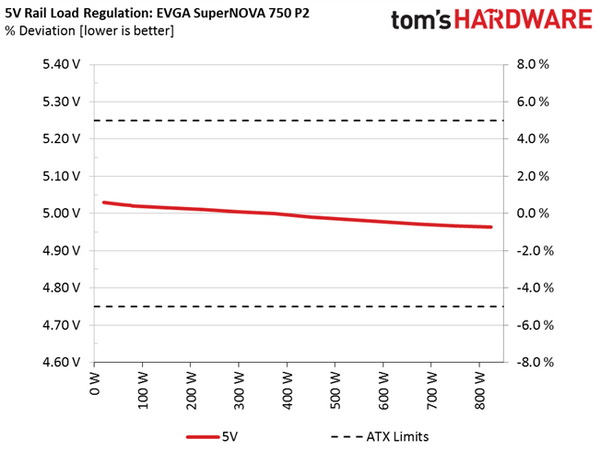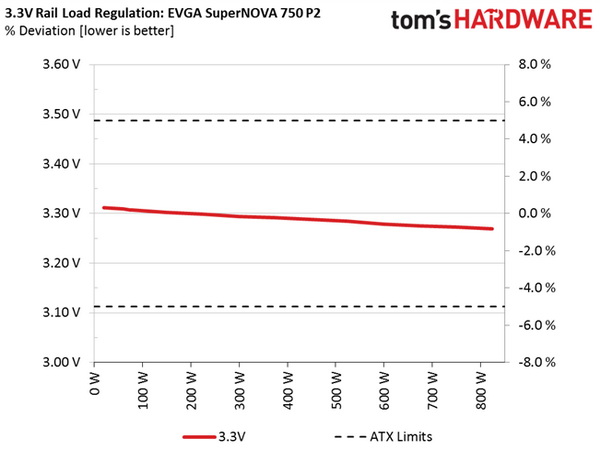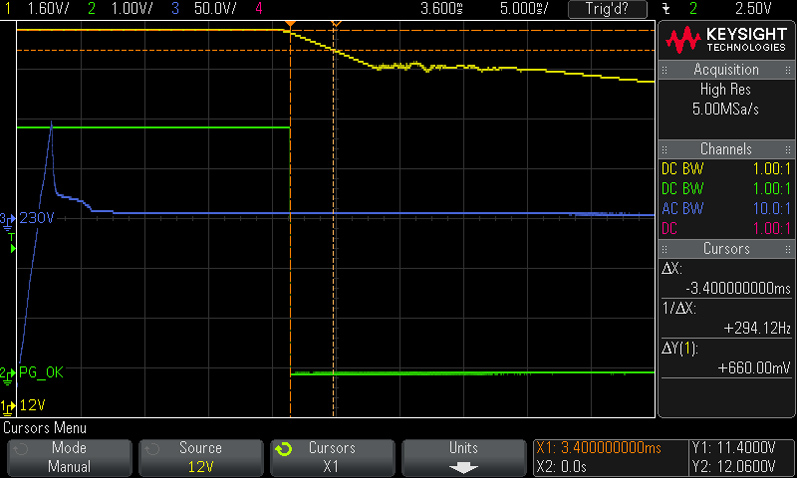EVGA SuperNOVA 750 P2 PSU Review
Another EVGA P2 is on our test bench today. The 750 P2 features 750W max power, modular cabling and Japanese caps throughout. This PSU promises high performance and increased reliability, so it looks to be a great choice for enthusiast PCs.
Why you can trust Tom's Hardware
Load Regulation, Hold-Up Time And Inrush Current
To learn more about our PSU tests and methodology, please check out How We Test Power Supply Units.
Primary Rails And 5VSB Load Regulation
Load Regulation testing is detailed here.








Hold-Up Time
Our hold-up time tests are described in detail here.







The hold-up time we recorded is much longer than the ATX spec requires, and the power-good signal drops before the rails go out of spec. We're all good here.
Inrush Current
For details on our inrush current testing, please click here.


The inrush current measurements are normal with both voltage inputs.
Load Regulation And Efficiency Measurements
The first set of tests reveals the stability of the voltage rails and the PSU's efficiency. The applied load equals (approximately) 10 to 110 percent of the maximum load the supply can handle, in increments of 10 percentage points.
Get Tom's Hardware's best news and in-depth reviews, straight to your inbox.
We conducted two additional tests. During the first, we stressed the two minor rails (5V and 3.3V) with a high load, while the load at +12V was only 0.10A. This test reveals whether a PSU is Haswell-ready or not. In the second test, we determined the maximum load the +12V rail could handle with minimal load on the minor rails.
| Test | 12V | 5V | 3.3V | 5VSB | PowerDC/AC(Watts) | Efficiency(%) | FanSpeed (RPM) | FanNoisedB(A) | TempIn/Out(°C) | PF/AC(V) |
|---|---|---|---|---|---|---|---|---|---|---|
| 1 | 4.340A | 1.995A | 1.994A | 0.986A | 74.80 | 85.83 | 0 | 0 | 49.74 | 0.923 |
| 12.256V | 5.021V | 3.307V | 5.069V | 87.15 | 38.99 | 115.1V | ||||
| 2 | 9.703A | 2.990A | 2.995A | 1.185A | 149.73 | 90.10 | 0 | 0 | 51.99 | 0.960 |
| 12.249V | 5.015V | 3.302V | 5.055V | 166.18 | 39.95 | 115.1V | ||||
| 3 | 15.417A | 3.498A | 3.514A | 1.385A | 224.88 | 91.22 | 0 | 0 | 53.83 | 0.981 |
| 12.245V | 5.010V | 3.299V | 5.043V | 246.53 | 40.92 | 115.1V | ||||
| 4 | 21.120A | 3.995A | 4.004A | 1.590A | 299.71 | 91.45 | 0 | 0 | 55.49 | 0.984 |
| 12.241V | 5.005V | 3.294V | 5.029V | 327.72 | 41.54 | 115.1V | ||||
| 5 | 26.507A | 4.999A | 5.011A | 1.790A | 374.67 | 91.29 | 920 | 35.9 | 44.24 | 0.987 |
| 12.231V | 4.999V | 3.291V | 5.016V | 410.41 | 50.74 | 115.1V | ||||
| 6 | 31.910A | 6.014A | 6.022A | 1.996A | 449.61 | 91.00 | 920 | 35.9 | 44.61 | 0.989 |
| 12.216V | 4.991V | 3.288V | 5.002V | 494.07 | 51.52 | 115.1V | ||||
| 7 | 37.314A | 7.020A | 7.032A | 2.200A | 524.55 | 90.62 | 920 | 35.9 | 44.89 | 0.991 |
| 12.207V | 4.984V | 3.284V | 4.989V | 578.87 | 52.32 | 115.1V | ||||
| 8 | 42.716A | 8.041A | 8.051A | 2.410A | 599.54 | 90.00 | 920 | 35.9 | 45.75 | 0.992 |
| 12.200V | 4.977V | 3.279V | 4.975V | 666.17 | 53.84 | 115.1V | ||||
| 9 | 48.546A | 8.546A | 8.578A | 2.412A | 674.50 | 89.30 | 1370 | 46.3 | 47.46 | 0.993 |
| 12.193V | 4.972V | 3.275V | 4.972V | 755.32 | 56.23 | 115.1V | ||||
| 10 | 54.348A | 9.064A | 9.075A | 2.515A | 749.38 | 88.79 | 1370 | 46.3 | 47.72 | 0.994 |
| 12.184V | 4.967V | 3.273V | 4.964V | 844.02 | 56.86 | 115.1V | ||||
| 11 | 60.540A | 9.068A | 9.080A | 2.519A | 824.26 | 88.22 | 1840 | 52.3 | 48.59 | 0.995 |
| 12.175V | 4.964V | 3.269V | 4.959V | 934.31 | 58.31 | 115.1V | ||||
| CL1 | 0.099A | 12.012A | 12.006A | 0.004A | 100.58 | 83.34 | 920 | 35.9 | 45.76 | 0.946 |
| 12.267V | 4.981V | 3.291V | 5.087V | 120.69 | 51.65 | 115.2V | ||||
| CL2 | 62.444A | 1.004A | 1.003A | 1.002A | 773.61 | 89.38 | 1370 | 46.3 | 47.91 | 0.994 |
| 12.175V | 4.997V | 3.285V | 5.033V | 865.58 | 54.79 | 115.1V |
With 20% load, the efficiency looks good. It's notably below the required 92% at 50% load, though. Under full load, efficiency is very close to the 80 PLUS Platinum specification's 89% requirement. Frankly, we expected higher efficiency at mid-load. Then again, high operating temperatures increase energy losses, so we should expect to see efficiency take a hit in our taxing test environment.
Load regulation is fairly tight on each rail except 5VSB, while the PSU operates in fanless mode at up to the 40% load test. The fan rotates at its lowest speed in the following four tests, while at 90% load and up the fan's noise starts to get annoying. You really have to push the PSU at its limits to make the fan spin at full speed though. At that point, our measurement equipment registers greater than 50 dB(A). Again, we think the fan control circuit should be more granular.
Current page: Load Regulation, Hold-Up Time And Inrush Current
Prev Page A Look Inside And Component Analysis Next Page Efficiency, Temperature And Noise
Aris Mpitziopoulos is a contributing editor at Tom's Hardware, covering PSUs.
-
Nuckles_56 Thanks for the review Aris. I'd have to say that I'm very impressed with the performance of this unit, it is excellent. It is also nice to see that it has no issues with holdup times either.Reply -
theyeti87 It was the P2 650 review on Tom's that helped me decide on buying that unit. Same as this, just 100 watts less powerful. Extremely happy with the stability and quiet operation. Very reliable units!Reply -
AfiliaSaga I have their G2 750W superflower unit, fantastic performance couldn't be happier with it.Reply -
refillable Another great product from EVGA. I regret belittling EVGA with their early PSUs. I also mistakenly said, "I don't like that EVGA PSU"...Reply
With SuperFlower, they're known to bring greatness now. Anyone looking for "Good PSUs" should go straight to these units and buy them. Exceptional value with excellent performance. Sadly, they're still not available in my country. -
dstarr3 Reply18119171 said:Another great product from EVGA. I regret belittling EVGA with their early PSUs. I also mistakenly said, "I don't like that EVGA PSU"...
With SuperFlower, they're known to bring greatness now. Anyone looking for "Good PSUs" should go straight to these units and buy them. Exceptional value with excellent performance. Sadly, they're still not available in my country.
Right on. Unless you need significantly more or significantly less power, there's no reason to buy anything else.


